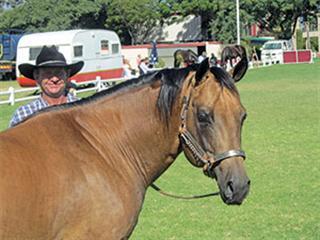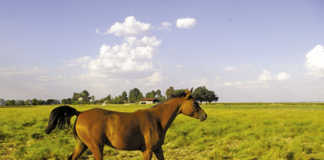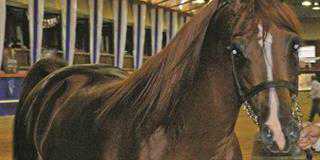
A recent newspaper story described how a breeding stallion attacked its handler at a show, injuring her arm badly. Stallions should be taught to respect their handlers from an early age. This is particularly important with breeding stallions, as they have a high level of testosterone, the male hormone associated with aggression as well as fertility. Stallion handling is based on good horsemanship – gaining respect without intimidation. Bullying is counter-productive, as it fuels aggression.
Early training
Good behaviour starts when the stallion is a colt, just weaned from its mother. By the time it’s two or three years old, it’s very difficult to re-programme its behaviour, particularly if the stallion’s already mated mares. The first step is to keep it standing still while being haltered. You may initially need a lot of assistants or a crush to restrain the colt when putting on the halter, and it’s advisable to leave the halter on for a few weeks to make the stallion easier to catch.
Once you’ve caught the stallion, concentrate on making it stand still while you push and pull on the halter. You can put on and take off a second halter over the first, to get the colt used to being caught. Once the halter is on, the horse must stand still while you handle it, not chew on the lead rope or fidget.
When leading a colt, teach it to respect your space. Once the halter is on, it should not circle around you – push it backwards, away from you, and walk into it until the colt yields. Always push the colt’s head away from you to turn it. Don’t let it turn towards you, as it will end up circling you.
Hands and voice
It’s important to hold the colt fairly short, with your left hand just below its chin and the rest of the lead lightly coiled in your other hand. Go with it if it starts to rear, so your weight brings it back to earth quickly. Always work in a stable to start with, then a lunge ring or ‘round pen’. If the colt pulls to the end of the thick cotton lead rope (which should never be made of nylon as it will tear your hands if the horse pulls on it), let it go.
Then chase it onwards so it doesn’t enjoy ‘being free’. Let it tread on the lead rope and say “Whoa!” every time it does so. Eventually the stallion will come to a halt and you can pick up the lead rope, quieten the animal with your hands and voice, and continue the lesson. Colts should be socialised. Keep young stallions in a group with mature geldings and work them in company, so they learn to behave in company. Mature breeding stallions should be kept in paddocks adjacent to geldings and not isolated.
Body language
Mature stallions can be unpredictable. The only way to make sure you stay in control is to always watch their body language. Pinning their ears back, shifting their shoulder into your way or leaning on the lead rope are attempts at dominance. You need to react immediately, moving into their space and making sure they respect yours. With an older stallion, this can be done by using the point of your elbow against their neck or shoulder, pushing them backwards, or jerking once or twice hard on the lead rope.
Shouting, screaming or using a whip to try and instil fear usually doesn’t work, as the stallion can sense your fear and take advantage of it. It’s better to be calm, but firm at all times. Instil discipline, then reward the stallion by leaving it alone once it relaxes.
Contact Dr Mac at [email protected]. Please state ‘Horse talk’ in the subject line of your email.













